… they only come out a night. Augmented reality has to be considered as part of the future of humankind. There are many ways for us to add data to our lives beyond the what is there physically.This could be called metadata. In Snow Crash, a piece of hard and speculative scienc fiction by Neal Stephenson, they talk about Gargoyles: augmented reality users who are constantly feeding into the net from behind lenses like the ones above. In this novel, Stephenson used this as a derogatory term, but augmented reality can be playful and active rather than the stoicism and coldness behind what word “gargoyle” typically suggests. Augmented reality is a new form that appears personally empowering. And, as Michel Foucault said, knowledge is power.
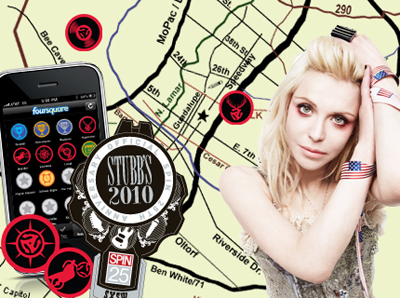
"Virtual Reality is often defined as an opaque experience that is separate from the real world. But mobile devices are melting into our reality instead of taking us away from it. We are using information to connect us to people and to plan the experiences of our future self and those around us. We are using personal mobile devices as video game controllers for the world around us. Virtual Reality has dissolved into actual reality." Amber Case
Although carving gargoyles was a common enough occupation in the Middle Ages, there has been little work for a would-be gargoyle sculptor to sink his chisel and imagination into over the past four hundred odd years. Churches have sustained the market for sitting, standing , or air-borne saints, angels and cherubim, carved of stone or wood, right through the centuries , but gargoyles have become passé; that is until a Muslim stonemason became immortalized as a winged gargoyle at a Catholic cathedral in Lyon, France.
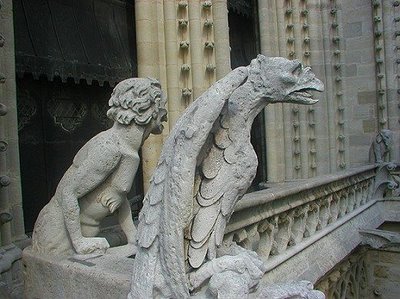
As for their generic name, their proper designation is "chimera" since they are not functional, but are purely ornamental creatures. They are not, and never were, possessed of a "gargouille" or throat.
…”Now the priest had taught and fought through all the war, and his hair had grown white, but his eyes had grown young. And he said, “I was wrong and they are right. The sun, the symbol of our father, gives life to all those earthly things that are full of ugliness and energy. All the exaggerations are right, if they exaggerate the right thing. Let us point to heaven with tusks and horns and fins and trunks and tails so long as they all point to heaven. The ugly animals praise God as much as the beautiful. The frog’s eyes stand out of his head because he is staring at heaven. The giraffe’s neck is long because he is stretching towards heaven. The donkey has ears to hear–let him hear.” …
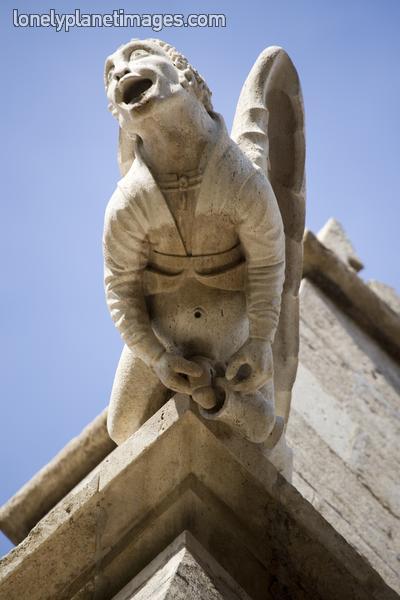
So what, then, is the Gothic? Essentially, it is a literature of nightmare. Said to have originated with Horace Walpole’s Castle of Otranto (1764) in the eighteenth century, the Gothic deals with fears common to all humankind, fears both external and internal. Indeed, it is frequently the case that what terrorises the individual “out there,” has originated from within
A Muslim stonemason who spent nearly four decades helping to restore an Roman Catholic cathedral in France has been immortalized as a winged gargoyle peering out from its facade — albeit with the inscription “God is great” at his clawed feet written in French and Arabic. This ostensible sign of inter-religious friendship is rooted in the Medieval tradition and reflects the city of Lyon’s links to its large Muslim population. However, a widely publicized outcry from a tiny extreme-right group has forced the Archdiocese of Lyon into damage control.

Gary Varner: The Green Man could be a gargoyle if it had a water spout but I don’t believe any of the ancient Green Man forms do. Green Men are grotesques rather than gargoyles. A “grotesque” may have many of the design elements of the gargoyle but they have taken a totally divergent path. One scholar noted “Grotesque art, then, expresses the repressed.”
“I’d have to support Jeunes identitaires Lyonnais in general. It’s good to know these sorts of organized voices are still working. I hope they keep working. I hope they overthrow the Judaeo-masonic Fifth Republic and bring back a Catholic monarchy. I’m not sure this culture has been represented accurately. It must be a bad joke on a “friend” to put anything like his likeness in a gargoyle. Gargoyle’s are frightful reminders of demons and damnation. They’re not happy nor blessed. Gargoyle’s are tortured figures. Who in his right mind would feel complemented to have his face likened in a gargoyle? A Mason and a Mormon like Glenn Beck? Not me. They should put a tortured image of Glenn Beck in a gargoyle maybe. That might be funny.”
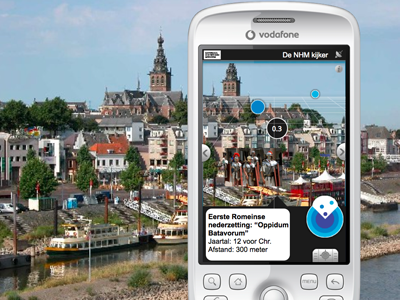
"We are gaming animals. All throughout history, games were substitutes and simulations of war. Now our wars are fun. They're soft wars. The race to get the most followers and most views on a website. The race to share. They're still very evolutionary, we're just playing the game on a different platform that doesn't involve us physically as much as mentally and strategically. We've become emperors of our own empires, sending out robotic troops to scrape websites, gather RSS feeds and plot trajectories on digital maps. We have robots that grab and tell us our stats. We count our troops. We have Facebook walls that, when printed out, would span the length of Egyptian temples. They'd also contain as just as much history." Amber Case
Ahmed Benzizine, a practicing Muslim born in Algeria, a former French colony, sees the gargoyle in his image as “a message of peace and tolerance.” This is a new twist on symbolic theological significance that held that even monstrous evil forces can do good work. The joke may be on Benzizine since in tangible form the gargoyle represented the ever-present threat of the devil, a reminder that prepared the worshipper to enter God’s house and seek salvation. “Good” was said to exist within the cathedral walls and “Evil” without. Benz
e is immortalized as the outsider and not permitted into the warmth of god’s womb.
"The Benzizine gargoyle has been in place for about six months, but until recently, few people noticed. However, a recent campaign by a small extreme-right group denouncing the likeness of a Muslim on a Catholic institution and the inscription proclaiming "God is great" in French and Arabic — 'Dieu est grand, Allahu akbar' — has put everyone on the defensive, even Benzizine."
Carl Jung observes “A symbol always stands for something more than its obvious and immediate meaning. Symbols, moreover, are natural and spontaneous products. No genius has ever sat down with a pen or brush in hand and invented a symbol. No one can take a more or less rational thought, reached as a logical conclusion or by deliberate intent, and than give it “symbolic form”. There are many symbols, however, that are not individual but collective in their nature and origin. These are chiefly religious images. The believer assumes that they are of divine origin – that they have been revealed to man.

The most likely truth is that all of these elements come together in explaining both the existence and our attraction to gargoyles and grotesques; the conscious, the unconscious, primitive religion, myth, Christian conversion, practicality and certainly the stone cutter's joy of creation. The images under consideration embody profound symbolic content from our "collective unconscious" and are significant and enduring symbolic manifestations of the human experience.
The skeptic says flatly that they have been invented. Both are both somewhat right and wrong. . It is true, as the skeptic notes, that religious symbols and concepts have for centuries been the object of careful and quite conscious elaboration. It is equally true, as the believer implies, that their origin is so far buried in the mystery of the past that they seem to have no human source. But they are in fact “collective representations,” emanating from primeval dreams and creative fantasies. As such, these images are involuntary spontaneous manifestations and by no means intentional inventions.”

Chrysler Building gargoyle. Chesterton: "And for some reason after this men began to talk quite differently about the temple and the sun. Some, indeed, said, "You must not touch the temple; it is classical; it is perfect, since it admits no imperfections." But the others answered, "In that it differs from the sun, that shines on the evil and the good and on mud and monsters everywhere."...
Benzizine, who arrived in France in 1970, is tickled to see his likeness on the facade of the cathedral, which dates to the 12th to 14th centuries and combines both Gothic and Roman architecture.”It looks like me except for the ears,” said the 59-year-old Benzizine. “They’re pointed like the devil. But the sculptor told me that angels have pointed ears, too.” For Emmanuel Fourchet, the sculptor who immortalized Benzizine in stone, “it was an occasion to pay tribute.”
Gargoyles can be traced back 4000 years to Egypt, Rome and Greece. Terra cotta water spouts depicting: lions, eagles, and other creatures, including those based on Greek and Roman mythology, were very common. Gargoyle water spouts were even found at the ruins of Pompeii. The first grotesque figures came from Egypt. The Egyptians believed in deities with the heads of animals and frequently replicated these deities in their architecture and wall paintings. When the Greeks saw the Sphinx, they began to incorporate grotesques into their own beliefs.
…And under the new inspiration they planned a gorgeous cathedral in the Gothic manner, with all the animals of the earth crawling over it, and all the possible ugly things making up one common beauty, because they all appealed to the god. The columns of the temple were carved like the necks of giraffes; the dome was like an ugly tortoise; and the highest pinnacle was a monkey standing on his head with his tail pointing at the sun. And yet the whole was beautiful, because it was lifted up in one living and religious gesture as a man lifts his hands in prayer. ( Chesterton )
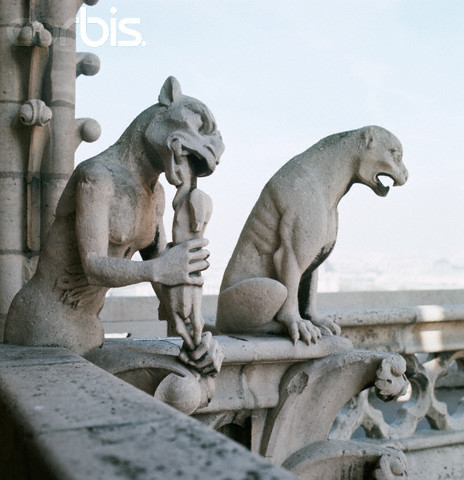
St. Bernard of Clairvaux-the 12th Century A.D. observed: "What are these fantastic monsters doing in the cloisters under the very eyes of the brothers as they read? What is the meaning of these unclean monkeys, strange savage lions and monsters? To what purpose are here placed these creatures, half beast, half man? I see several bodies with one head and several heads with one body. Here is a quadruped with a serpent's head, there a fish with a quadruped's head, then again an animal half horse, half goat... Surely if we do not blush for such absurdities we should at least regret what we have spent on them."
The Greeks believed in many grotesques such as harpies, centaurs, griffins, and chimeras. Greek architects would often place statues of animals called acroterium, in the forms of griffins, at each corner of the roof of their treasuries and temples. In Greek mythology, griffins guarded the gold of Scythia from the Arimaspians, a race of one eyed giants or Cyclops, who would try to steal the gold.
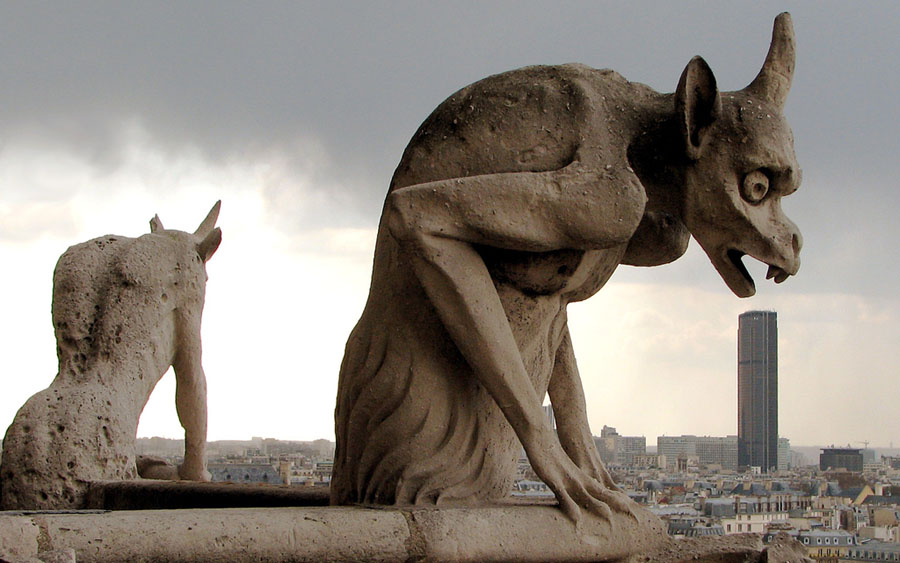
Notre Dame Cathedral. Gargoyles and grotesques have always given carvers and sculptors a chance to delight in their creativity and to explore the possibilities in the dance between stone and imagination. Gargoyles freed carvers from the limits imposed by other types of carving, and this was especially true in the Middle Ages. It is certain that stone carvers love creating these pieces, and viewers certainly love seeing them. This may be one of the more compelling reasons they exist.
For centuries scholars have asked why gargoyles inhabit their most solemn churches and institutions. Fantastic explanations have come down from the Middle Ages. Some art historians believe that gargoyles were meant to depict evil spirits over which the Christian church had triumphed. One theory suggests that these devils were frozen in stone as they fled the church. Supposedly, Christ set these spirits to work as useful examples to men instead of sending them straight to damnation. others say they kept evil spirits away. Psychologists suggest that gargoyles represent the fears and superstitions of medieval men. As life became more secure, the gargoyles became more comical and whimsical.
…But this great plan was never properly completed. The people had brought up on great wagons the heavy tortoise roof and the huge necks of stone, and all the thousand and one oddities that made up that unity, the owls and the efts and the crocodiles and the kangaroos, which hideous by themselves might have been magnificent if reared in one definite proportion and dedicated to the sun. For this was Gothic, this was romantic, this was Christian art; this was the whole advance of Shakespeare upon Sophocles. And that symbol which was to crown it all, the ape upside down, was really Christian; for man is the ape upside down…. ( Chesterton )
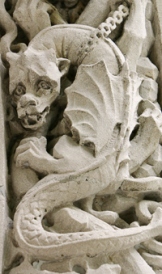
"Long ago in the country of France a dragon named La Gargouille would come out of his cave near the river Seine to swallow ships and destroy property with his fiery breath. In order to appease him, the people of Rouen would feed him a live victim each year. It was known that La Gargouille preferred innocent maidens, but the townspeople usually offered him one of their convicts. St. Romanus, a priest who came to Rouen about 600 A.D., persuaded the villagers to let him deal with the dragon. The villagers promised to be baptized and to build a church if he subdued La Gargouille. Laden with the equipment of exorcism -bells, books, candles, and crosses - St. Romanus and that year's convict disappeared behind some great beechwoods on the other side of Seine. A few hours later, they merged from the grove, leading La Gargouille by a leash fashioned from the priest's robe. The citizens of the town tied the dragon to a stake and built a great fire around him. Only the neck and head did not burn; they were accustomed to being heated by the dragon's fiery breath."
The term “gargoyle” is actually something of a misnomer. Technically, gargoyles have a waterspout issuing from their mouths, their function being to drain water away from the roof. (The word gargoyle shares the same root as “gargle” and comes from the Old French word gargouille which means “throat”). Figures without waterspouts are more properly referred to as “grotesques.”
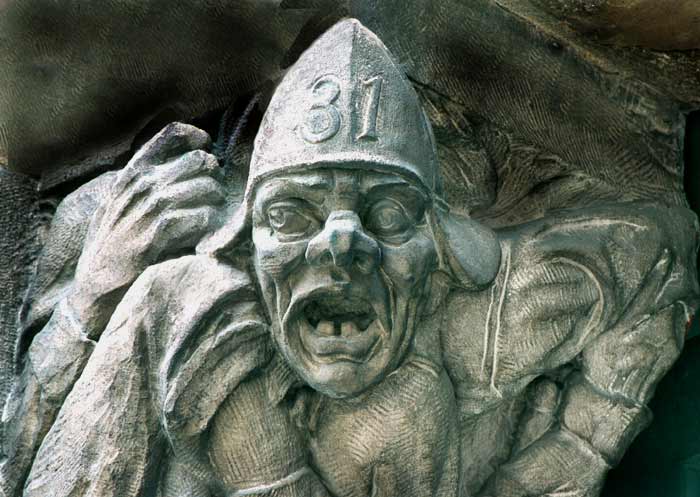
Gargoyles crafted during Medieval times became increasingly grotesque in design. Soon they were referred to as “chimeras” because of their representations of creatures that were not of this world - half man, and half bird or beast. These new incarnations were either depicted sitting on their haunches or poised to take flight. They also possessed over exaggerated muzzles or beaks and other odd appendages.
So, to isolate gargoyles from a strictly medieval viewpoint, would be erroneous. However, the most famous example of horror art are the gargoyles on Notre Dame de Paris, the ancient and famous French cathedral; except these beasts, perched in saucy attitudes on the parapets are neither ancient or true gargoyles. They sprang from the imagination of the nineteenth-century restorer of Gothic monuments Viollet-le-Duc, and not from the whimsey of a thirteenth-century carver.
…But the rich, who had grown riotous in the long peace, obstructed the thing, and in some squabble a stone struck the priest on the head and he lost his memory. He saw piled in front of him frogs and elephants, monkeys and giraffes, toadstools and sharks, all the ugly things of the universe which he had collected to do honour to God. But he forgot why he had collected them. He could not remember the design or the object. He piled them all wildly into one heap fifty feet high; and when he had done it all the rich and influential went into a passion of applause and cried, “This is real art! This is Realism! This is things as they really are!”… ( Chesterton )
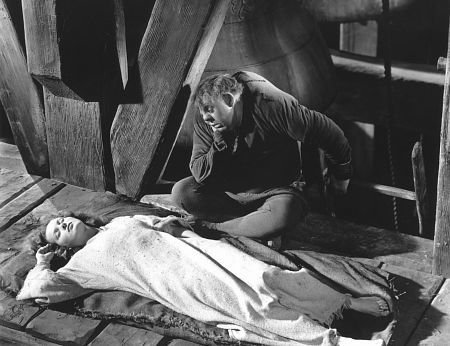
Gargoyle as a symbol of repressed desire? Is the myth in the hunch? "Da Vinci Code fanatics and conspiracy theorists will doubtless make some secret symbolic connection between these gargoyles and the minds of medieval masons, and of course such hybrid chimeras have made appearances in popular culture everywhere from The Hunchback of Notre Dame to Ghostbusters. Do they threaten damnation or worse to sinners? Judgement Day awaits in Paris."
“…That, I fancy, is the only true origin of Realism. Realism is simply Romanticism that has lost its reason. This is so not merely in the sense of insanity but of suicide. It has lost its reason; that is its reason for existing. The old Greeks summoned godlike things to worship their god. The medieval Christians summoned all things to worship theirs, dwarfs and pelicans, monkeys and madmen. The modern realists summon all these million creatures to worship their god; and then have no god for them to worship. Paganism was in art a pure beauty; that was the dawn. Christianity was a beauty created by controlling a million monsters of ugliness; and that in my belief was the zenith and the noon. Modern art and science practically mean having the million monsters and being unable to control them; and I will venture to call that the disruption and the decay. The finest lengths of the Elgin marbles consist splendid houses going to the temple of a virgin. Christianity, with its gargoyles and grotesques, really amounted to saying this: that a donkey could go before all the horses of the world when it was really going to the temple. Romance means a holy donkey going to the temple. Realism means a lost donkey going nowhere. ( Chesterton )

"Though Murnau's Nosferatu was actually an unauthorized adaptation of Bram Stoker's Dracula, Herzog based his film largely on Murnau's conceptions--at times directly quoting Murnau's images--but manages to slip in a few references to Tod Browning's famous version (at one point the vampire comments on the howling wolves: "Listen, the children of the night make their music."). Longtime Herzog star Klaus Kinski is both hideous and melancholy as Nosferatu (renamed Count Dracula in the English language version). As in Murnau's film, he's a veritable gargoyle with his bald pate and sunken eyes, and his talon-like fingernails and two snaggly fangs give him a distinctly feral quality. But Kinski's haunting eyes also communicate a gloomy loneliness--the curse of his undead immortality--and his yearning for Lucy (Isabelle Adjani) becomes a melancholy desire for love."
I SAW a mouth jeering. A smile of melted red iron ran over it. Its laugh was full of nails rattling. It was a child’s dream of a mouth.
A fist hit the mouth: knuckles of gun-metal driven by an electric wrist and shoulder. It was a child’s dream of an arm.
The fist hit the mouth over and over, again and again. The mouth bled melted iron, and laughed its laughter of nails rattling.
And I saw the more the fist pounded the more the mouth laughed. The fist is pounding and pounding, and the mouth answering. ( Carl Sandberg, Gargoyle )
a


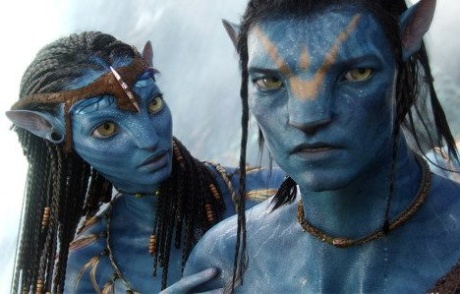



 COMMENTS
COMMENTS